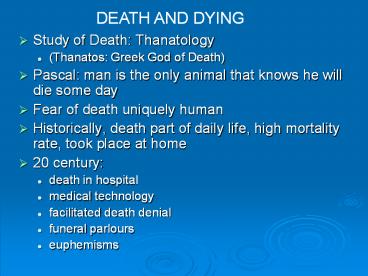Study of Death: Thanatology - PowerPoint PPT Presentation
Title:
Study of Death: Thanatology
Description:
About age 9-10 we realize that death is final, universal and inevitable ... Mourning: behaviours that express grief. Rituals: e.g. Irish wake, sitting shiva. Stages: ... – PowerPoint PPT presentation
Number of Views:2488
Avg rating:3.0/5.0
Title: Study of Death: Thanatology
1
DEATH AND DYING
- Study of Death Thanatology
- (Thanatos Greek God of Death)
- Pascal man is the only animal that knows he will
die some day - Fear of death uniquely human
- Historically, death part of daily life, high
mortality rate, took place at home - 20 century
- death in hospital
- medical technology
- facilitated death denial
- funeral parlours
- euphemisms
2
- About age 9-10 we realize that death is final,
universal and inevitable - Adolescence invulnerable, immortal cant happen
to me, risk taking, denial - Early adulthood change when becoming parents
- Middle age death of parents, friends, siblings.
Highest death anxiety - Old age lowest anxiety, though facing death of
spouse and peers - Role of religion true believers and atheists
lowest anxiety
3
- What is death?
- Determined by doctor (if available). Errors
- Clinical death heart and lungs stop. But
nowadays resuscitation through technology CPR,
oxygen, defibrillation, etc. (NDEs) - Brain death no EEG. New structures (cerebral
cortex) die first, then midbrain, then medulla
and spinal cord (vegetative functions and
reflexes) is this person alive? Coma
4
- Euthanasia active or passive
- Active method used to terminate life, e.g. drug,
asphyxia, etc. - Special case assisted suicide (Kevorkian)
- Passive withhold or remove life support
- Ethical issue Nazis
- Issue of longevity and economics
- Cultural variations, Netherlands
- NDE Near death experience, increase since
resuscitations increased
5
- First thanatologist Elizabeth Kubler-Ross
- Process in 5 stages
- Denial
- Anger
- Bargaining
- Depression
- Acceptance
- Not a typical stage process individual
differences, order of stages, return to earlier
stages - Also observed in chronic illness, loss of body
parts, loss of function
6
- Schneidman alternation of emotions instead of
stages - grief
- anguish
- anger
- anxiety
- denial
- NO acceptance
7
- Pattison living-dying interval, prolonged by
technology - 3 phases
- acute crisis time of diagnosis
- chronic gradual deterioration, longest phase due
to medical-technological advances - surrender giving up, not a real acceptance
- Variables that affect process
- age
- cause of death
- personality
- religious beliefs
- ethnic background
- hospital, home or hospice location
8
- Survivors
- Grief feelings
- Mourning behaviours that express grief
- Rituals e.g. Irish wake, sitting shiva
- Stages
- numbness
- yearning, anger and denial
- depression, apathy, disorganization
- acceptance, adjustment, reorganization
- All 4 can coexist and alternate
9
- Varying time span, influence of culture
- Child and spouse worst
- Widows/widowers longer grieving if bad marriage
sanctification of dead spouse (guilt) - Increase in morbidity and mortality (one study in
text contradicts) - Double whammy
- immune system weakens
- self neglect (meals, exercise, sleep, smoking and
drinking)
10
- Psychoneuroimmunology
- Psycho thoughts and feelings
- Neuro brain and nervous system
- Immuno immune system
- Logy study of
- People who have supports fare better
- Anticipatory grief helps (when death is expected)






![[PDF]❤️DOWNLOAD⚡️ Stratagem of the Corpse: Dying with Baudrillard, a Study of Sickness and Simul PowerPoint PPT Presentation](https://s3.amazonaws.com/images.powershow.com/10046744.th0.jpg?_=20240603068)
























